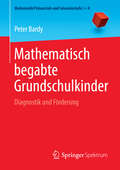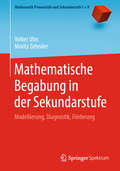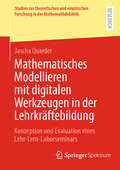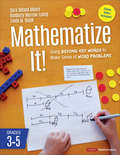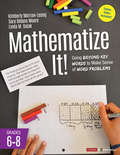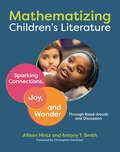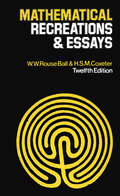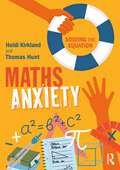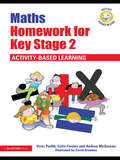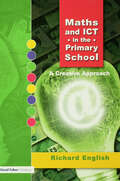- Table View
- List View
Mathematikunterricht in der Praxis: Konkrete Anregungen für die Sekundarstufe I und II
by Kai MüllerDieses Buch schlägt eine Brücke zwischen Fachdidaktik und Unterrichtspraxis der Mathematik: Referendare, Lehramtsstudierende und Lehrende der Sekundarstufe I und II finden hier konkrete Anregungen und Beispiele für Ihren eigenen Unterricht, die in der Praxis erprobt sind. Die Kapitel sind auch unabhängig voneinander lesbar – das Buch lädt daher sowohl zur gezielten Suche nach Unterrichtsbeispielen als auch zum Schmökern und Entwickeln eigener Ideen ein. Die Anordnung der Kapitel spiegelt die übliche Reihenfolge bei der Unterrichtsplanung wider. Die einzelnen Anregungen sind jeweils kompakt und übersichtlich gestaltet: Sie stellen das Fachliche in den Vordergrund, um zu zeigen, wie sich daraus Didaktik und Methodik ergeben. Thematisch werden alle fünf Leitideen der Bildungsstandards aufgegriffen: Algorithmus und Zahl, Messen, Raum und Form, funktionaler Zusammenhang, Daten und Zufall. Der Autor Kai Müller ist Diplomphysiker mit Schwerpunkt theoretische Physik und Mathematik. Er hat sich vor allem der fachdidaktischen Ausbildung von Referendaren verschrieben – zunächst als Gymnasial-Lehrer und seit einigen Jahren zusätzlich als Lehrbeauftragter an der Universität Heidelberg sowie dem Seminar für Ausbildung und Fortbildung der Lehrkräfte (Gymnasium). Stimmen zum Buch Das Buch zeigt anschaulich an exemplarisch dargestellten Unterrichtsstunden, wie sich guter Unterricht machen lässt. Es überbrückt die Kluft zwischen Theorie und Praxis […] nicht in Form abgehobener theoretischer Analysen, vielmehr liefert es jenen, die vor den Klassen stehen, attraktive und erprobte Bausteine für die Gestaltung einer Unterrichtsstunde. Prof. Dr. Christian Hesse, Universität Stuttgart
Mathematisch begabte Grundschulkinder: Diagnostik und Förderung (Mathematik Primarstufe und Sekundarstufe I + II)
by Peter BardyNach den Diskussionen über das Abschneiden deutscher Schülerinnen und Schüler in internationalen Vergleichsstudien (TIMMS,PISA,IGLU-E) haben auch die Diagnose und die Förderung begabter Kinder mittlerweile bei uns zunehmend öffentliche Aufmerksamkeit gefunden. Die Probleme mathematisch begabter Grundschulkinder und ihre spezifischen Bedürfnisse sind aber bisher nur wenig bekannt geworden. Hier besteht ein erheblicher Nachholbedarf in der Aus-, Fort- und Weiterbildung von Grundschullehrerinnen und -lehrern. Das vorliegende Buch informiert Sie ausführlich über: - Erfahrungen mit mathematisch begabten Grundschulkindern (einschließlich einiger Fallstudien) - Begabungsmodelle - das Phänomen "mathematische Begabung" - die Diagnose mathematischer Begabung im Grundschulalter - Ziele und Organisationsformen der Förderung - Schwerpunkte der Förderung: Verwendung heuristischer Hilfsmittel, allgemeine Strategien des Lösens mathematischer Probleme, logisches/schlussfolgerndes Denken, Argumentieren/Begründen/Beweisen, Strukturen erkennen, Verallgemeinern/Abstrahieren, Kreativität, selbstständiges Erweitern/Variieren von Problemstellungen, räumliches Vorstellungsvermögen - zahlreiche geeignete Aufgabenformate mit Eigenproduktionen von Kindern - ergiebige mathematische Themenfelder Das Buch wendet sich an Studierende des Lehramts an Grundschulen, an Lehramtsanwärterinnen und -anwärter, an Lehrkräfte sowie an Eltern.
Mathematisch begabte Kinder und Jugendliche: Theorie und (Förder-)Praxis (Mathematik Primarstufe und Sekundarstufe I + II)
by Thomas Bardy Peter BardySchon länger ist bekannt, dass auch die Entwicklung begabter Kinder und Jugendlicher nicht von allein verläuft, sondern vielfältiger Unterstützung vor allem durch Elternhaus und Schule bedarf. Die Förderung interessierter und begabter Mädchen und Jungen ist deshalb eine wichtige Aufgabe der Schule vom ersten Schultag an. Dies gilt selbstverständlich auch für die Mathematik. Mit dem geplanten Buch sollen aktuelle theoretische Grundlagen zum Themenkreis „mathematische Begabung“ zur Verfügung gestellt werden. Diese umfassen zunächst eine Einführung in Theorien und Modelle zum (allgemeinen) Begabungsbegriff und Beziehungen zum Konstrukt „Intelligenz“. Schwerpunkt sind Konzepte zum Konstrukt „mathematische Begabung“ in Grundschule und Sekundarstufe I. Wichtig ist den Autoren, dass Begabungsmerkmale dabei an geeigneten mathematischen Problemstellungen (die Leserinnen und Leser zunächst auch selbst bearbeiten können) und authentischen Schülerprodukten erläutert werden. Außerdem werden auch Facetten wie „neurowissenschaftliche Grundlagen mathematischer Begabung“ oder „mathematisch begabte Mädchen“ beleuchtet.
Mathematische Begabung in der Sekundarstufe: Modellierung, Diagnostik, Förderung (Mathematik Primarstufe und Sekundarstufe I + II)
by Volker Ulm Moritz ZehnderDas Buch widmet sich grundlegenden Fragen zu mathematischer Begabung mit Fokus auf Schülerinnen und Schüler der Sekundarstufen I und II. Der Begabungsbegriff wird perspektivenreich mit Bezug zum Fach Mathematik beleuchtet. Es werden praxiserprobte Konzepte zur Diagnostik mathematischer Begabung und zur Förderung mathematisch besonders begabter Schülerinnen und Schüler vorgestellt. Dabei steht insbesondere der reguläre, alltägliche Mathematikunterricht im Blickfeld. Er wird als primärer Ort für Begabungsförderung gesehen. Zudem werden Anregungen gegeben, wie an Schulen Mathematikunterricht systematisch hin zu bewusst begabungsförderndem Unterricht weiterentwickelt werden kann. Damit richtet sich das Buch an Lehramtsstudierende des Faches Mathematik, Lehrende an Hochschulen im Bereich Mathematikdidaktik sowie Mathematiklehrkräfte an Schulen der Sekundarstufen.
Mathematisches Modellieren mit digitalen Werkzeugen in der Lehrkräftebildung: Konzeption und Evaluation eines Lehr-Lern-Laborseminars (Studien zur theoretischen und empirischen Forschung in der Mathematikdidaktik)
by Jascha QuarderDie vorliegende Arbeit stellt die Konzeption und Evaluation des Lehr-Lern-Laborseminars MiRA-digital zum mathematischen Modellieren mit digitalen Werkzeugen dar. MiRA-digital wird als fachdidaktisches Seminar im Rahmen der ersten Phase der Lehrkräftebildung an der Universität Münster angeboten. Das Seminar zeichnet sich durch eine Theorie-Praxis-Verzahnung sowie komplexitätsreduzierte Rahmenbedingungen aus und zielt darauf ab, Mathematiklehramtsstudierende bereichsspezifisch (d.h. für den Unterrichtsbereich des mathematischen Modellierens mit digitalen Werkzeugen) zu professionalisieren. Die Evaluation des Seminars bezieht sich auf die Wirksamkeit dieser Professionalisierung und erfolgt mittels einer quantitativen quasi-experimentellen Interventionsstudie im Prä-Post-Design. Mit Fokus auf das bereichsspezifische Aufgabenwissen und das bereichsspezifische adaptive Interventionswissen wurden Daten von N = 165 Studierenden über vier Semester erhoben und kumulativ ausgewertet. Die Ergebnisse zeigen, dass die Entwicklung der beiden bereichsspezifischen Wissensarten positiv und signifikant durch die Teilnahme am Seminar MiRA-digital beeinflusst wird. In einem Lehr-Lern-Laborseminar zum mathematischen Modellieren ohne digitale Werkzeuge und einer Kontrollgruppe konnte hingegen keine umfassende signifikante Entwicklung dieser Wissensarten festgestellt werden. Damit wird die Wirksamkeit des Lehr-Lern-Laborseminars MiRA-digital bestätigt.
Mathematisches Modellieren: als fachlicher Hintergrund für die Sekundarstufe I +II (Mathematik Primarstufe und Sekundarstufe I + II)
by Sebastian BauerDas Buch richtet sich an Studierende und Lehrende des Lehramts der Sekundarstufe sowie an Lehrerinnen und Lehrer der Sekundarstufe. Es baut auf Grundkenntnissen in der Analysis und der Linearen Algebra, wie sie gewöhnlich in den ersten Semestern des Studiengangs erworben werden, auf und knüpft an typische Modellierungsaufgaben aus der Schulpraxis an. Hierbei werden besonders bedeutende, historisch interessante oder ästhetisch ansprechende mathematische Modelle unterschiedlicher Bezugswissenschaften zusammen mit der dafür benötigten mathematischen Theorie entwickelt und dargestellt. Dabei erfolgt die nötige Theorieentwicklung immer in enger Verzahnung mit den betrachteten mathematischen Modellen. Typische Vorgehensweisen des Modellierens, wie Dimensionsanalysen, Vereinfachung durch Linearisierung, Isolierung verschiedener Effekte und Vernachlässigung kleiner Effekte, werden im Verlauf der Darstellung immer wieder aufgegriffen. Auf diese Weise ermöglicht das Werk Lehrkräften einen fachlich „höheren Standpunkt“ zu den schulischen Möglichkeiten und Anforderungen des Mathematischen Modellierens.
Mathematize It! [Grades 3-5]: Going Beyond Key Words to Make Sense of Word Problems, Grades 3-5 (Corwin Mathematics Series)
by Linda M. Gojak Sara Delano Moore Kimberly Morrow-Leong"The list of math books to truly synthesize what we know so far and what we need to know is a very short and exclusive list. Well, you can confidently add Mathematize It to this collection. Written by three of the most respected math educators today, the book zeros in on that often poorly traveled journey between the question and answer in problem solving. Mathematize It will be your go-to resource to install the mathematical play revolution in elementary classes everywhere!" Suni Singh Author of Pi of Life: the Hidden Happiness of Mathematics and Math Recess: Playful Learning in an Age of Disruption Help students reveal the math behind the words "I don’t get what I’m supposed to do!" This is a common refrain from students when asked to solve word problems. Solving problems is about more than computation. Students must understand the mathematics of a situation to know what computation will lead to an appropriate solution. Many students often pluck numbers from the problem and plug them into an equation using the first operation they can think of (or the last one they practiced). Students also tend to choose an operation by solely relying on key words that they believe will help them arrive at an answer, which without careful consideration of what the problem is actually asking of them. Mathematize It! Going Beyond Key Words to Make Sense of Word Problems, Grades 3-5 shares a reasoning approach that helps students dig into the problem to uncover the underlying mathematics, deeply consider the problem’s context, and employ strong operation sense to solve it. Through the process of mathematizing, the authors provide an explanation of a consistent method—and specific instructional strategies—to take the initial focus off specific numbers and computations and put it on the actions and relationships expressed in the problem. Sure to enhance teachers’ own operation sense, this user-friendly resource for Grades 3–5 • Offers a systematic mathematizing process for students to use when solving word problems • Gives practice opportunities and dozens of problems to leverage in the classroom • Provides specific examples of questions and explorations for all four operations (addition, subtraction, multiplication, and division) with whole numbers, fractions, and decimals • Demonstrates the use of concrete manipulatives to model problems with dozens of short videos • Includes end-of-chapter activities and reflection questions How can you help your students understand what is happening mathematically when solving word problems? Mathematize it!
Mathematize It! [Grades 3-5]: Going Beyond Key Words to Make Sense of Word Problems, Grades 3-5 (Corwin Mathematics Series)
by Linda M. Gojak Sara Delano Moore Kimberly Morrow-Leong"The list of math books to truly synthesize what we know so far and what we need to know is a very short and exclusive list. Well, you can confidently add Mathematize It to this collection. Written by three of the most respected math educators today, the book zeros in on that often poorly traveled journey between the question and answer in problem solving. Mathematize It will be your go-to resource to install the mathematical play revolution in elementary classes everywhere!" Suni Singh Author of Pi of Life: the Hidden Happiness of Mathematics and Math Recess: Playful Learning in an Age of Disruption Help students reveal the math behind the words "I don’t get what I’m supposed to do!" This is a common refrain from students when asked to solve word problems. Solving problems is about more than computation. Students must understand the mathematics of a situation to know what computation will lead to an appropriate solution. Many students often pluck numbers from the problem and plug them into an equation using the first operation they can think of (or the last one they practiced). Students also tend to choose an operation by solely relying on key words that they believe will help them arrive at an answer, which without careful consideration of what the problem is actually asking of them. Mathematize It! Going Beyond Key Words to Make Sense of Word Problems, Grades 3-5 shares a reasoning approach that helps students dig into the problem to uncover the underlying mathematics, deeply consider the problem’s context, and employ strong operation sense to solve it. Through the process of mathematizing, the authors provide an explanation of a consistent method—and specific instructional strategies—to take the initial focus off specific numbers and computations and put it on the actions and relationships expressed in the problem. Sure to enhance teachers’ own operation sense, this user-friendly resource for Grades 3–5 • Offers a systematic mathematizing process for students to use when solving word problems • Gives practice opportunities and dozens of problems to leverage in the classroom • Provides specific examples of questions and explorations for all four operations (addition, subtraction, multiplication, and division) with whole numbers, fractions, and decimals • Demonstrates the use of concrete manipulatives to model problems with dozens of short videos • Includes end-of-chapter activities and reflection questions How can you help your students understand what is happening mathematically when solving word problems? Mathematize it!
Mathematize It! [Grades 6-8]: Going Beyond Key Words to Make Sense of Word Problems, Grades 6-8 (Corwin Mathematics Series)
by Linda M. Gojak Sara Delano Moore Kimberly Morrow-LeongHelp students reveal the math behind the words "I don’t get what I’m supposed to do!" This is a common refrain from students when asked to solve word problems. Solving problems is about more than computation. Students must understand the mathematics of a situation to know what computation will lead to an appropriate solution. Many students often pluck numbers from the problem and plug them into an equation using the first operation they can think of (or the last one they practiced). Students also tend to choose an operation by solely relying on key words that they believe will help them arrive at an answer, without careful consideration of what the problem is actually asking of them. Mathematize It! Going Beyond Key Words to Make Sense of Word Problems, Grades 6–8 shares a reasoning approach that helps students dig into the problem to uncover the underlying mathematics, deeply consider the problem’s context, and employ strong operation sense to solve it. Through the process of mathematizing, the authors provide an explanation of a consistent method—and specific instructional strategies—to take the initial focus off specific numbers and computations and put it on the actions and relationships expressed in the problem. Sure to enhance teachers’ own operation sense, this user-friendly resource for Grades 6–8: · Offers a systematic mathematizing process for students to use when solving word problems · Gives practice opportunities and dozens of problems to leverage in the classroom · Provides specific examples of questions and explorations for multiplication and division, fractions and decimals, as well as operations with rational numbers · Demonstrates the use of visual representations to model problems with dozens of short videos · Includes end-of-chapter activities and reflection questions How can you help your students understand what is happening mathematically when solving word problems? Mathematize it!
Mathematize It! [Grades 6-8]: Going Beyond Key Words to Make Sense of Word Problems, Grades 6-8 (Corwin Mathematics Series)
by Linda M. Gojak Sara Delano Moore Kimberly Morrow-LeongHelp students reveal the math behind the words "I don’t get what I’m supposed to do!" This is a common refrain from students when asked to solve word problems. Solving problems is about more than computation. Students must understand the mathematics of a situation to know what computation will lead to an appropriate solution. Many students often pluck numbers from the problem and plug them into an equation using the first operation they can think of (or the last one they practiced). Students also tend to choose an operation by solely relying on key words that they believe will help them arrive at an answer, without careful consideration of what the problem is actually asking of them. Mathematize It! Going Beyond Key Words to Make Sense of Word Problems, Grades 6–8 shares a reasoning approach that helps students dig into the problem to uncover the underlying mathematics, deeply consider the problem’s context, and employ strong operation sense to solve it. Through the process of mathematizing, the authors provide an explanation of a consistent method—and specific instructional strategies—to take the initial focus off specific numbers and computations and put it on the actions and relationships expressed in the problem. Sure to enhance teachers’ own operation sense, this user-friendly resource for Grades 6–8: · Offers a systematic mathematizing process for students to use when solving word problems · Gives practice opportunities and dozens of problems to leverage in the classroom · Provides specific examples of questions and explorations for multiplication and division, fractions and decimals, as well as operations with rational numbers · Demonstrates the use of visual representations to model problems with dozens of short videos · Includes end-of-chapter activities and reflection questions How can you help your students understand what is happening mathematically when solving word problems? Mathematize it!
Mathematize It! [Grades K-2]: Going Beyond Key Words to Make Sense of Word Problems, Grades K-2 (Corwin Mathematics Series)
by Linda M. Gojak Sara Delano Moore Kimberly Morrow-Leong"This book is a must-have for anyone who has faced the challenge of teaching problem solving. The ideas to be learned are supported with a noticeably rich collection of classroom-ready problems, examples of student thinking, and videos. Problem solving is at the center of learning and doing mathematics. And so, Mathematize It! should be at the center of every teacher’s collection of instructional resources." John SanGiovanni Coordinator, Elementary Mathematics Howard County Public School System, Ellicott City, MD Help students reveal the math behind the words "I don’t get what I’m supposed to do!" This is a common refrain from students when asked to solve word problems. Solving problems is about more than computation. Students must understand the mathematics of a situation to know what computation will lead to an appropriate solution. Many students often pluck numbers from the problem and plug them into an equation using the first operation they can think of (or the last one they practiced). Students also tend to choose an operation by solely relying on key words that they believe will help them arrive at an answer, which without careful consideration of what the problem is actually asking of them. Mathematize It! Going Beyond Key Words to Make Sense of Word Problems, Grades K-2 shares a reasoning approach that helps students dig into the problem to uncover the underlying mathematics, deeply consider the problem’s context, and employ strong operation sense to solve it. Through the process of mathematizing, the authors provide an explanation of a consistent method—and specific instructional strategies—to take the initial focus off specific numbers and computations and put it on the actions and relationships expressed in the problem. Sure to enhance teachers’ own operation sense, this user-friendly resource for Grades K-2 · Offers a systematic mathematizing process for students to use when solving word problems · Gives practice opportunities and dozens of problems to leverage in the classroom · Provides specific examples of questions and explorations for addition and subtraction of whole numbers as well as early thinking for multiplication and division · Demonstrates the use of concrete manipulatives to model problems with dozens of short videos · Includes end-of-chapter activities and reflection questions How can you help your students understand what is happening mathematically when solving word problems? Mathematize it!
Mathematize It! [Grades K-2]: Going Beyond Key Words to Make Sense of Word Problems, Grades K-2 (Corwin Mathematics Series)
by Linda M. Gojak Sara Delano Moore Kimberly Morrow-Leong"This book is a must-have for anyone who has faced the challenge of teaching problem solving. The ideas to be learned are supported with a noticeably rich collection of classroom-ready problems, examples of student thinking, and videos. Problem solving is at the center of learning and doing mathematics. And so, Mathematize It! should be at the center of every teacher’s collection of instructional resources." John SanGiovanni Coordinator, Elementary Mathematics Howard County Public School System, Ellicott City, MD Help students reveal the math behind the words "I don’t get what I’m supposed to do!" This is a common refrain from students when asked to solve word problems. Solving problems is about more than computation. Students must understand the mathematics of a situation to know what computation will lead to an appropriate solution. Many students often pluck numbers from the problem and plug them into an equation using the first operation they can think of (or the last one they practiced). Students also tend to choose an operation by solely relying on key words that they believe will help them arrive at an answer, which without careful consideration of what the problem is actually asking of them. Mathematize It! Going Beyond Key Words to Make Sense of Word Problems, Grades K-2 shares a reasoning approach that helps students dig into the problem to uncover the underlying mathematics, deeply consider the problem’s context, and employ strong operation sense to solve it. Through the process of mathematizing, the authors provide an explanation of a consistent method—and specific instructional strategies—to take the initial focus off specific numbers and computations and put it on the actions and relationships expressed in the problem. Sure to enhance teachers’ own operation sense, this user-friendly resource for Grades K-2 · Offers a systematic mathematizing process for students to use when solving word problems · Gives practice opportunities and dozens of problems to leverage in the classroom · Provides specific examples of questions and explorations for addition and subtraction of whole numbers as well as early thinking for multiplication and division · Demonstrates the use of concrete manipulatives to model problems with dozens of short videos · Includes end-of-chapter activities and reflection questions How can you help your students understand what is happening mathematically when solving word problems? Mathematize it!
Mathematizing
by Allen C. RosalesThis proven, accessible approach to a curriculum presents a learner-centered approach to math education. Mathematizing provides both the emergent curriculum and professional development frameworks to help young children learn math throughout their everyday routine and to facilitate teachers' understanding of how to see and support children's math learning at every turn. With this book and its plentitude of case studies, illustrations, photographs, and documentation, the mathematizing adult can interpret children's interests and use that knowledge as a catalyst for creating meaningful and purposeful mathematical lessons and interactions.
Mathematizing Children's Literature: Sparking Connections, Joy, and Wonder Through Read-Alouds and Discussion
by Allison Hintz Antony T. SmithMany teachers use traditional counting and shape books in math class. But what would happen if we approached any story with a math lens? How might mathematizing children's literature give learners space to ask their own questions, and make connections between stories, their lives, and the world around them? These are the questionsauthors Allison Hintz and Antony T. Smith set out to explore in Mathematizing Children's Literature: Sparking Connections, Joy, and Wonder Through Read-Alouds and Discussion as they invite us to consider fresh ways of using interactive read-alouds to nurture students as both readers and mathematicians.Inside Mathematizing Children's Literature , you'll learn how to do the following: Select picture books according to the goals of the read aloud experiencePlan and facilitate three styles of read aloud discussions - Open Notice and Wonder, Math Lens, and Story Explore UtilizeIdea Investigations - experiences that invite students to pursue literacy and math-focused ideas beyond the pages of the read aloudConnect withstudents' families and communities through storiesAlong the way, Hintz and Smith provide a wide range of picture book suggestions and appendices that include ready-to-use lesson planning templates, a form for notes, and a bookmark of guiding questions. Mathematizing Children's Literature is a practical resource you'll find yourself referring to frequently.
Mathematizing Your School: Creating a Culture for Math Success
by Nicki Newton Janet NuzzieLearn the secrets to getting your entire school excited about math! This book from acclaimed author Dr. Nicki Newton and experienced instructional specialist Janet Nuzzie shows you how to integrate engaging math instruction at every level, from the small group project to the school-wide assembly. With contributions from math coaches, district leaders, and classroom teachers, this book will give you the practical tools you need to boost student proficiency, encourage collaboration between staff members, and make math an important part of school life. You’ll also learn how to: Create a safe and inviting environment for mathematics instruction; Devote adequate amounts of instructional time to help students develop their skill set as proficient mathematicians; Use real-world contexts and hands-on instruction to boost engagement; Give students the tools and opportunities to be confident, to question, to take risks, and to make mistakes; And much much more!
Matherätsel (nicht nur) für Begabte der Klassen 4 bis 6: Erst wiegen, dann wägen, dann wagen!
by Tatiana S. SamrowskiDas vorliegende Buch enthält eine Zusammenstellung der bekanntesten klassischen arithmetischen Textaufgaben, ausgewählte Aufgaben aus Mathematikwettbewerben und viele neue, noch nie publizierte Probleme. Das Spektrum reicht von Zahlenrätseln über Scherzaufgaben, Verwandtschafts- und Altersknobeleien, Uhrzeitberechnung, Überfahrtsproblemen und vieles mehr bis hin zu Grundlagen der Kombinatorik und Zahlentheorie.Das Buch ist für Kinder ab 10 Jahren, ihre Eltern und diejenigen Lehrer bestimmt, die den praktischen Nutzen der Mathematik aufzeigen und kreatives logisches Denken fördern wollen.Für die zweite Auflage ist es vollständig durchgesehen und überarbeitet.
Mathmatical Recreations & Essays (12th Edition)
by H.S.M. Coxeter W. W. BallFor over eighty years this delightful classic has provided entertainment through mathematical problems commonly known as recreations. Although they often involve fundamental mathematical methods and notions, their chief appeal is as games or puzzles rather than the usefulness of their conclusions. This new edition upholds the original, but the terminology and treatment of problems have been updated and much new material has been added. There are new selections on polyominoes and the notion of dragon designs, and a new chapter, 'Introduction to Combinatorics.' Other topics dealt with in the fourteen chapters include arithmetical and geometrical recreations and problems, polyhedra, chess-board recreations, unicursal problems, cryptography and cryptanalysis, and calculating prodigies. Since no knowledge of calculus or analytic geometry is necessary to enjoy the recreations, this book will appeal widely to teachers of mathematics and students and to anyone who is mathematically inclined.
Maths 5–11: A guide for teachers (Primary 5-11 Series)
by Caroline ClissoldFocusing on good progression from Reception to Year 6, Maths 5–11 provides a clear and concise presentation of the fundamental knowledge that all primary mathematics teachers need. It provides readers with practical knowledge for the planning and assessment necessary to employ the theories expressed in the book. Ranging from number sense and place value to looking in depth at the various aspects of fractions and mathematical reasoning, this book explores: mathematical connections inside and outside of the curriculum; the relation of mathematics to other primary subjects such as science, geography, and art; mathematics teaching practices from high-performing jurisdictions across the world; the progression of learning from primary school to secondary school; the ‘big ideas’ in mathematics; and activities that provide strategies for children to use responsively and creatively. Helping primary teachers and mathematics coordinators improve and enhance their mathematical subject knowledge and pedagogy, Maths 5–11 will re-instil an excitement about teaching mathematics among its readers.
Maths Anxiety: Solving the Equation
by Thomas Hunt Heidi KirklandMaths Anxiety is a very common experience, reported by people around the world. This book will help all teachers of Maths, from primary education to secondary and beyond, to better understand Maths Anxiety and learn how we can address this within our classrooms, creating a more positive learning environment for all.Supported by research, case studies, and anecdotes, this highly practical book explores and provides answers to the following questions: What is Maths Anxiety? Who experiences it? Can I measure it? What is involved in Maths Anxiety? Who and what can influence it? What can we do to provide support? Can teachers experience Maths Anxiety too? An essential resource for anybody teaching or supporting the learning of Maths, this book provides tried and tested interventions to apply within the classroom, alongside strategies to use at school or at home to manage and alleviate student experiences of Maths Anxiety.
Maths Homework for Key Stage 2: Activity-Based Learning (Active Homework)
by Colin Forster Vicki Parfitt Andrea McGowanMaths Homework for Key Stage 2 is a unique resource for busy teachers – a selection of ‘pencil-free’, hands-on activities that teachers can use as extension activities or give to pupils as homework to do with members of their family or friends. Each of the activities encourages the pupils to learn through discussion and through practical activities utilising everyday resources. Each activity is quick and easy for pupils and teachers to manage, and includes: a learning aim full, clear instructions and discussion points tasks to develop collaboration and partnership between pupils, parents and teachers photocopiable resources. A refreshing approach for teachers and pupils, these activities will foster enthusiasm for learning and inspire pupils' interest in Maths.
Maths Learning Difficulties, Dyslexia and Dyscalculia: Second Edition (Dyslexia Essentials Ser.)
by Steve ChinnWritten by a world authority on maths difficulties in children, this accessible guide provides tried and tested visual strategies and tailored techniques to help teachers and parents support children with SpLDs who need help with maths.Drawing on the latest research, into areas such as cognition and meta-cognition, along with the authors' decades of teaching experience, the book offers insight into how maths learning difficulties, including dyslexia, dyscalculia and maths anxiety, make maths difficult. Each chapter looks at foundational areas of maths learning that children may struggle with, from early number experiences to basic addition and subtraction, times tables, measurement and more. Essential reading for any teacher, learning assistant or parent supporting children with maths.
Maths Unwrapped: The easy way to understand and master mathematics
by Mattias Ribbing Per SundinWhy do so many of us struggle to remember the maths we were taught at school? The answer is that we can successfully memorise things for a short period but we only retain those memories long term if we understand them. Mattias Ribbing is a Grand Master of Memory who will show you how to remember maths through truly understanding it. His methods are simple but will last for life, and unwrap the puzzle of maths forever.The key to confidence with numbers is not remembering complex rules surrounding long division or algebra; it's understanding the critical components of maths and being able to clearly visualise problems and solutions. This illuminating guide to improving your maths provides logical, long-term strategies that will enable you to finally get maths and hold on to that level of confidence thereafter.
Maths Unwrapped: The easy way to understand and master mathematics
by Mattias Ribbing Per SundinWhy do so many of us struggle to remember the maths we were taught at school? The answer is that we can successfully memorise things for a short period but we only retain those memories long term if we understand them. Mattias Ribbing is a Grand Master of Memory who will show you how to remember maths through truly understanding it. His methods are simple but will last for life, and unwrap the puzzle of maths forever.The key to confidence with numbers is not remembering complex rules surrounding long division or algebra; it's understanding the critical components of maths and being able to clearly visualise problems and solutions. This illuminating guide to improving your maths provides logical, long-term strategies that will enable you to finally get maths and hold on to that level of confidence thereafter.
Maths and ICT in the Primary School: A Creative Approach
by Richard EnglishBy clearly outlining how ICT can enhance and improve children’s learning, this book shows how to unleash the full potential of ICT within the classroom. Stimulating, useful and free of jargon, the book provides many practical examples to show teachers where, when and how ICT can be used effectively within their maths teaching. It provides advice on: teaching creatively choosing ICT resources differentiation assessing ICT making the most of adult support. Rooted in the practical realities of the classroom, this book will support both trainee and qualified teachers in providing rich and creative maths experiences through the use of ICT.
Maths class 10 - Tamil Nadu Board - SCERT: கணக்கு பத்தாம் வகுப்பு
by Scert Tamil Naduஇந்த 10-ம் வகுப்பு கணக்கு பாடத்தில் மேல் வகுப்பில் படிக்க போகும் கணக்குகளை பற்றி நாம் இந்த கணக்கு பாடத்தில் மிக சுலபமாக தெரிந்து கொள்ளலாம்.

